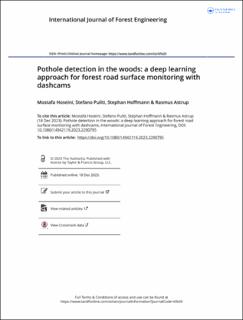Pothole detection in the woods: a deep learning approach for forest road surface monitoring with dashcams
Peer reviewed, Journal article
Published version
Permanent lenke
https://hdl.handle.net/11250/3112286Utgivelsesdato
2023-12-18Metadata
Vis full innførselSamlinger
- Divisjon for skog og utmark [521]
- Publikasjoner fra CRIStin - NIBIO [4575]
- Vitenskapelige artikler [1416]
Originalversjon
Hoseini, M., Puliti, S., Hoffmann, S., & Astrup, R. (2023). Pothole detection in the woods: a deep learning approach for forest road surface monitoring with dashcams. International Journal of Forest Engineering, 1–10. https://doi.org/10.1080/14942119.2023.2290795Sammendrag
Sustainable forest management systems require operational measures to preserve the functional design of forest roads. Frequent road data collection and analysis are essential to support target-oriented and efficient maintenance planning and operations. This study demonstrates an automated solution for monitoring forest road surface deterioration using consumer-grade optical sensors. A YOLOv5 model with StrongSORT tracking was adapted and trained to detect and track potholes in the videos captured by vehicle-mounted cameras. For model training, datasets recorded in diverse geographical regions under different weather conditions were used. The model shows a detection and tracking performance of up to a precision and recall level of 0.79 and 0.58, respectively, with 0.70 mean average precision at an intersection over union (IoU) of at least 0.5. We applied the trained model to a forest road in southern Norway, recorded with a Global Navigation Satellite System (GNSS)−fitted dashcam. GNSS-delivered geographical coordinates at 10 Hz rate were used to geolocate the detected potholes. The geolocation performance over this exemple road stretch of 1 km exhibited a root mean square deviation of about 9.7 m compared to OpenStreetMap. Finally, an exemple road deterioration map was compiled, which can be used for scheduling road maintenance operations.

